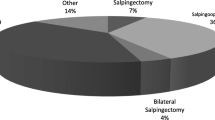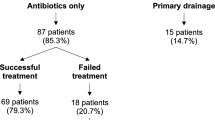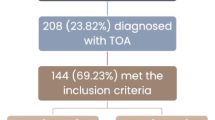Abstract
Purpose
Tubo-ovarian abscess (TOA) is a serious and potentially life-threatening complication of pelvic inflammatory disease (PID). TOA formation may be an uncommon, but serious complication associated with the use of an intrauterine device (IUD). While the majority of TOA respond to antibiotic therapy, in approximately 25% of cases surgery or drainage is indicated. In the present study, we compared the failure rate of conservative management in patients with and without IUD, who were admitted with a diagnosis of TOA.
Methods
In this retrospective case–control study, 78 women were diagnosed with TOA. All patients were treated initially by broad-spectrum intravenous antibiotics. The failure of conservative management after 72 h was followed by surgical intervention.
Results
The patients were divided into two groups: 24 patients were IUD-carriers, and 54 did not use IUD. There was no significant difference in surgical intervention rate between IUD group (50%) and no-IUD group (43%), p = 0.32. The WBC count was significantly higher in IUD-carriers diagnosed with TOA than in patients without IUD (16.5 ± 6.6 vs. 13.1 ± 4.6, p = 0.001). The patients with IUD had significantly larger abscesses as revealed by ultrasound than patients without IUD (61.6 ± 21.4 vs. 49.6 ± 20.6 mm, p = 0.02).
Conclusion
The surgical intervention rate in TOA patients with and without IUD was similar.
Similar content being viewed by others
Avoid common mistakes on your manuscript.
Introduction
Tubo-ovarian abscess (TOA) is a serious and potentially life-threatening complication of pelvic inflammatory disease (PID). TOA is defined as an inflammatory mass that involves fallopian tubes, ovary and sometimes adjacent pelvic organs such as bowels [1]. Approximately one-third of women who are hospitalized with a diagnosis of PID have been found to have a TOA [2]. In current practice, the mortality rate almost zero in unruptured abscesses, while previous reports suggested mortality rate ranging from 1.7 to 3.7% in ruptured abscesses [3, 4]. A tubo-ovarian abscess is a polymicrobial infectious condition. Both aerobic and anaerobic organisms have been isolated from TOAs [5]. Commonly isolated organisms include Escherichia coli, aerobic streptococci, Bacteroides fragilis [6].
Tubo-ovarian abscesses have similar risk factors as PID, including multiple sex partners, age between 15 and 25 years, and a prior history of PID [7]. Modern IUDs cause little-elevated risk for developing PID, especially within first 3 weeks after insertion. The use of an IUD has been associated with the formation of TOAs in previous reports [8, 9]. However, there is lack of well-designed studies to substantiate this association.
TOAs have typically been treated medically with broad-spectrum antibiotics. Patients are treated until they are afebrile for 48 h and tend to be switched to oral antibiotics for up to 14 days [10]. While the majority of TOA respond to antibiotic therapy, in approximately 25% of cases surgery or drainage is indicated [11]. Several factors have been reported to be associated with failure of conservative management. They include the prolonged duration of hospitalization, larger abscesses (greater than 8 cm) [3], higher CRP levels [12], older age, higher leukocyte count and parity [13], and prolonged use of IUD [14].
Common organisms associated with PID such as N. gonorrhoeae and C. trachomatis, are rarely isolated from the abscess cavity of a TOA. As the underlying pathogenesis and bacteriology of TOA associated with PID and with IUD may differ, one may expect that the clinical course may differ. It has been our clinical impression that the majorities of cases of TOA associated with IUD fail the initial antibiotic treatment and are consequently managed surgically. A literature search did not find studies addressing this issue.
The purpose of the current study is to compare the clinical characteristics of TOA patients with and without IUD; specifically as the surgical intervention rate.
Materials and methods
The medical records of consecutive patients diagnosed with TOA at Barzilai Medical Center between 1st January 2000 and 31st December 2013, were retrospectively reviewed. The institutional review board approved the study. The data included demographic characteristics, initial clinical symptoms, and antibiotic treatment before hospitalization, physical examination and laboratory findings. The diagnosis of TOA was made by ultrasonographic examination that revealed a presence of a complex, irregular, cystic adnexal mass with an opaque fluid. According to the protocol of our department, all patients were treated initially by broad-spectrum intravenous antibiotics, including clindamycin and ciprofloxacin. The removal of IUD was performed after initiation of antibiotic therapy. The failure of conservative management was defined as persistent fever above 38 °C, leukocytosis or pain for a period longer than 72 h, necessitating surgical drainage.
The study power analysis was performed. The proportion of assumed of TOA patients with IUD is assumed as one-third. Based on the literature, the proportion of surgical intervention in patients with and without IUD was assumed as 60 and 25%, respectively. With an Alfa of 0.05 and a power of 0.80, the sample size was determined as 68 patients. Results are presented as proportions or as mean ± SD values. Differences in variables between the groups were analyzed with Chi-square test or student’s t test and Chi-square test, as appropriate. A p value of less than 0.05 was considered significant.
Results
There were 78 women with TOA during the study period. They were divided into two groups: 24 patients were IUD-carriers, and 54 patients were without IUD. The demographic characteristics, obstetrics and gynecology history of patients were similar between groups (Table 1).
A higher proportion of women with IUD were treated by antibiotics before hospitalization (27 vs. 5%, p = 0.01) (Table 2). No significant difference was observed in presence of fever at admission between the groups. Pelvic examination revealed cervical motion tenderness in most patients from both groups. Vaginal discharge and palpable pelvic mass were diagnosed in a similar proportion of patients from two groups. The WBC count was significantly higher in IUD-carriers diagnosed with TOA than in patients without IUD (16.5 ± 6.6 vs. 13.1 ± 4.6, p = 0.001). The patients with IUD had significantly larger abscesses as revealed by ultrasound than patients without IUD (61.6 ± 21.4 vs. 49.6 ± 20.6 mm, p = 0.02). Five patients without IUD and one patient with IUD had bilateral TOA. There was no significant difference in surgical intervention rate between IUD group (50%) and no-IUD group (43%), p = 0.32.
Discussion
Tubo-ovarian abscess (TOA) is the most serious complication of the pelvic inflammatory disease. Tubo-ovarian abscess formation may be an uncommon but serious complication associated with the use of an intrauterine device (IUD) [9]. Most patients with TOA improve with conservative antibiotic treatment but about 25% of them need some kind of operative intervention [11].
To the best of our knowledge, this is the first study that compared the failure rate of conservative treatment in patients that was diagnosed to have TOA with and without IUD. We did not find a difference in operation rate between the groups (50% in IUD group and 43% in no-IUD group). This rate is higher than previously reported (about 25%). A higher proportion of women with IUD were treated by antibiotics before hospitalization (27 vs. 5%, p = 0.01). This finding can be explained by the higher index of suspicion of PID in IUD-carriers. In previous studies, the older age and a higher parity were described as the risk factors for failure of medical treatment [13]. In line with these findings, the age, the parity, and the operation rate were similar in two groups of patients in our study. Contrary to previous publications that described a higher WBC levels and larger abscesses (above 6–8 cm) as a risk factors for operation [13], in our study patients with IUD had significantly higher leukocyte levels (16.5 vs 13.1) and significantly larger abscesses (61.6 vs 49.6 mm), however, the operation rates were similar in these patients despite the differences between two groups.
The limitations of this study include a retrospective design and a small number of patients.
In conclusion, according to our results, IUD is not a risk factor for medical treatment failure in patients diagnosed to have TOA.
References
Granberg S, Gjelland K, Ekerhovd E (2009) The management of pelvic abscess. Best Res Clin Obstet Gynaecol 23(5):667
Sorbiye IK, Jerve F, Staff AC (2005) Reduction in hospitalized women with pelvic inflammatory disease in Oslo over the past decade. Acta Obstet Gynecol Scand 84(3):290
Pedowitz P, Bloomfield RD (1964) Ruptured adnexal abscess with generalized peritonitis. Am J Obstet Gynecol 88:721
Rosen M, Breitkopf D, Waud K (2009) Tubo-ovarian abscess management options for women who desire fertility. Obstet Gynecol Surv 64(10):681
Wiesenfeld HC, Sweet RL (1993) Progress in the management of tubo-ovarian abscesses. Clin Obstet Gynecol 36(2):433
Landers DV, Sweet RL (1983) Tubo-ovarian abscess: a contemporary approach to management. Rev Infect Dis 5:876–884
Chappell C, Wiesenfeld HC (2012) Pathogenesis, diagnosis, and management of severe pelvic inflammatory disease and tubo-ovarian abscess. Clin Obstet Gynecol 55(4):893–903
Scott WC (1978) Pelvic abscess in association with intrauterine contraceptive device. Am J Obstet Gynecol 131(2):149
Toglia MR, Schaffer JI (1996) Tubo-ovarian abscess formation in users of intrauterine device remote from insertion: a report of three cases. Infect Dis Obstet Gynecol 4:85–88
Levenson RB, Pearson KM, Saokar A, Lee SI, Mueller PR, Hahn PF (2011) Image-guided drainage of tuboovarian abscesses of gastrointestinal or genitourinary origin: a retrospective analysis. J Vasc Interv Radiol 22:678–686
Granberg S, Gjelland K, Ekerhovd E (2009) Best practice and research. Clin Obstet Gynecol 23(5):667–678
Kuo CF, Tsai SY, Liu TC, Lin CC, Liu CP, Lee CM (2012) Clinical characteristics and treatment outcomes of patients with tubo-ovarian abscess at a tertiary care hospital in Northern Taiwan. J Microb Immun Infect 45:58–64
Greenstein Y, Shah AJ, Vragovic O, Cabral H, Soto-Wright V, Borgatta L, Kuohung W (2013) Tuboovarian abscess. Factors associated with operative intervention after failed antibiotic therapy. J Reprod Med 58(3–4):101–106
Halperin R, Levinson O, Yaron M, Bukovsky I, Schneider D (2003) Tubo-ovarian abscess in older women: is the women’s age a risk factor for failed response to conservative treatment? Gynecol Obstet Invest 55(4):211–215
Author information
Authors and Affiliations
Contributions
VK: manuscript writing-editing, data analyzing. AN: manuscript editing, data analyzing. OY: data collection. MV: data collection. EA: supervisor. OG: supervisor, project administration, manuscript editing, data analyzing.
Corresponding author
Ethics declarations
Conflict of interest
We have no potential conflict of interest to declare.
Ethical approval
This article does not contain any studies with human participants or animals performed by any of the authors.
Informed consent
The study was designed as a retrospective study. All data were collected anonymously. The Ethical board waived informed consent.
Rights and permissions
About this article
Cite this article
Kapustian, V., Namazov, A., Yaakov, O. et al. Is intrauterine device a risk factor for failure of conservative management in patients with tubo-ovarian abscess? An observational retrospective study. Arch Gynecol Obstet 297, 1201–1204 (2018). https://doi.org/10.1007/s00404-018-4690-z
Received:
Accepted:
Published:
Issue Date:
DOI: https://doi.org/10.1007/s00404-018-4690-z




